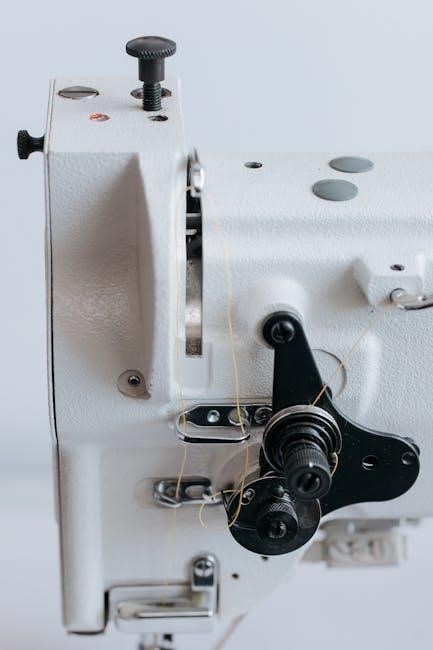Welcome to the AR-15 Operation Manual. This guide provides comprehensive instructions for safe handling, assembly, and operation of the AR-15 rifle. It covers essential safety protocols, key components, and step-by-step procedures for proper use and maintenance. Whether you’re a new or experienced user, this manual ensures responsible ownership and optimal performance of your firearm.
1.1 Overview of the AR-15 Rifle
The AR-15 is a semi-automatic, gas-operated rifle designed for versatility and precision. Originally developed for military use, it has become a popular choice for civilian shooters due to its modular design and adaptability. The rifle features a lightweight aluminum upper receiver and a durable lower receiver, allowing for easy customization with various accessories. Its gas system ensures reliable cycling, and the interchangeable barrel system enables users to adapt the rifle for different calibers and applications. Whether for target shooting, hunting, or self-defense, the AR-15’s ergonomic design and accuracy make it a favored firearm among enthusiasts and professionals alike. Proper understanding of its components and operation is essential for safe and effective use.
1.2 Importance of Following the Manual
Adhering to the AR-15 operation manual is crucial for ensuring safety, proper functionality, and legal compliance. The manual provides detailed instructions for handling, assembling, and maintaining the rifle, helping users avoid potential hazards. By following the guidelines, shooters can prevent accidents, maintain the firearm’s performance, and comply with local and federal regulations. Proper understanding of the manual ensures responsible ownership and minimizes risks associated with misuse. It also provides a foundation for troubleshooting and maintaining the rifle’s reliability. Always refer to the manual before handling the AR-15 to guarantee safe and effective operation. Failure to follow instructions can lead to legal consequences, damage to the firearm, or personal injury. Consistent adherence to the manual is essential for both novice and experienced users.
1.3 Safety Precautions
Always treat the AR-15 as if it were loaded, keeping the muzzle pointed in a safe direction away from people and objects. Wear safety glasses and ear protection during use. Ensure the firearm is unloaded before cleaning, transporting, or storing it. Never insert a loaded magazine into the rifle without chambering a round. Familiarize yourself with the manual and follow proper assembly and disassembly procedures to avoid accidental discharge. Be mindful of your surroundings and avoid distractions while handling the rifle. Store the AR-15 in a secure location, out of reach of children and unauthorized individuals. Regularly inspect the firearm for damage or wear and ensure all parts are functioning correctly. Always follow local and federal safety guidelines and regulations. Failure to adhere to these precautions can result in serious injury or legal consequences.

Key Components of the AR-15
The AR-15 comprises essential parts including the upper and lower receivers, barrel, gas system, magazine, and stock, each critical for its functionality, durability, and accuracy.
2.1 Upper Receiver Assembly
The upper receiver assembly is a critical component of the AR-15, housing the barrel, gas system, and charging handle. It is typically constructed from aluminum alloy for durability and lightweight performance. The assembly includes the handguard, which protects the user from heat and provides a mounting platform for accessories like optics or rail systems. The ejection port is also part of the upper receiver, allowing spent casings to be expelled during operation. The barrel is securely attached using a barrel nut, and the gas tube connects to the gas block, enabling the rifle’s semi-automatic functionality. Proper alignment and assembly of these components are vital for reliable operation and accuracy.
2.2 Lower Receiver Assembly
The lower receiver assembly is the foundation of the AR-15, serving as the serialized core of the rifle. Constructed from aluminum alloy, it houses essential components such as the magazine well, trigger group, and pistol grip. The buffer tube is attached to the lower receiver, accommodating the buffer and spring, which are critical for the rifle’s recoil system. The assembly also includes the safety selector switch, enabling the user to transition between safe, semi-automatic, and burst modes. Properly assembled, the lower receiver integrates seamlessly with the upper receiver, ensuring reliable functionality. Regular maintenance of this assembly, particularly the trigger group and buffer system, is essential for optimal performance and reliability.
2.3 Barrel and Gas System
The barrel and gas system are critical components of the AR-15, directly impacting its performance and reliability. The barrel, typically constructed from chrome-lined or stainless steel, is rifled to impart spin on the bullet for accuracy. The gas system, including the gas block, tube, and regulator, harnesses expanding gases from fired rounds to cycle the action. This system enables the rifle to chamber the next round automatically. Variations include carbine, mid-length, and rifle-length systems, each offering different balances of reliability and velocity. Proper alignment and maintenance of these components are essential to ensure consistent operation and prevent malfunctions during use.
2.4 Magazine and Ammunition
The AR-15 uses a detachable box magazine, typically with a 30-round capacity, though smaller sizes are available. Magazines are constructed from aluminum, steel, or polymer, ensuring durability and reliability. The rifle is chambered for 5.56x45mm NATO or .223 Remington ammunition, with the 5.56mm round being more powerful. It is essential to use high-quality ammunition that meets NATO specifications to ensure proper function and accuracy. The magazine should be cleaned regularly to prevent dirt and debris from affecting feeding. Always verify that the magazine is fully seated and latched to avoid malfunctions during operation. Proper ammunition selection and magazine maintenance are critical for reliable performance.

Assembly and Disassembly
Assembly and disassembly of the AR-15 require careful attention to detail to ensure proper function and safety. Use the correct tools, such as a punch and wrench, to avoid damaging components. Always follow a step-by-step process, starting with the upper receiver and then the lower, to maintain alignment and functionality. Regular disassembly is critical for cleaning and maintenance, ensuring the rifle operates reliably. Proper reassembly is equally important to restore the rifle to its original condition. Follow the manual closely to avoid errors during this process.
3.1 Tools Required for Assembly/Disassembly
The AR-15 assembly and disassembly process requires specific tools to ensure safety and prevent damage. Essential tools include a torque wrench for the barrel nut, an armorer’s wrench for the castle nut and delta ring, and a punch for the takedown pins. A receiver vice block is crucial for stabilizing the upper receiver during disassembly. Additional tools like a bore brush and cleaning rod may be needed for maintenance. Optional tools include a buffer tube wrench and a screwdriver for accessory removal. Always use the correct tools to avoid damaging components and ensure proper reassembly. Proper tool usage is vital for maintaining the rifle’s functionality and safety.
3.2 Step-by-Step Assembly Process
Begin by attaching the upper receiver to the lower receiver using the takedown pins. Ensure they are securely aligned and fully seated. Next, install the barrel nut onto the upper receiver, tightening it uniformly with a torque wrench to the manufacturer’s specifications. Attach the handguard, ensuring it is properly aligned and secured. Install the muzzle device, tightening it firmly. Attach the buttstock to the lower receiver, ensuring it is fully seated and secured with the castle nut. Finally, install the pistol grip, making sure it is tightly fastened. Double-check all components to ensure they are properly aligned and securely fastened before use.
3.3 Step-by-Step Disassembly Process
Begin by removing the magazine and ensuring the rifle is unloaded. Remove the pistol grip by taking out the screw. Next, detach the buttstock by loosening the castle nut and sliding it off. Remove the muzzle device by unscrewing it from the barrel. Take off the handguard by pulling it away from the upper receiver. Loosen the barrel nut using a torque wrench and remove it along with the barrel. Finally, separate the upper and lower receivers by pushing the takedown pins out. Store all components safely for cleaning or maintenance. Always ensure the rifle is unloaded before disassembling.

Operating the AR-15
Ensure the rifle is safe to operate, load the magazine, chamber a round, aim, and fire. Always follow safety protocols and proper handling techniques.
4.1 Loading the Magazine
Loading the magazine is a critical step in preparing the AR-15 for operation. Ensure the rifle is safe, with the bolt locked back and the safety selector in the “safe” position. Insert ammunition into the magazine, aligning the rounds properly to avoid misfeeding. The magazine capacity typically ranges from 10 to 30 rounds, depending on local laws and design. Gently push each round into the magazine until it clicks, ensuring it is fully seated. Once loaded, insert the magazine into the magazine well with a firm upward motion until it locks into place. Always double-check that the magazine is securely seated and the bolt is in the correct position before chambering a round. Avoid overloading, as this can cause feeding issues. Keep the muzzle pointed in a safe direction throughout the process.
4.2 Chambering a Round
Chambering a round is essential for preparing the AR-15 to fire. With the safety selector in the “safe” position, ensure the magazine is properly seated. Pull the charging handle fully rearward to eject any existing round and load a new one. Release the charging handle slowly, allowing the bolt to move forward and chamber the round. If equipped, use the forward assist to gently push the bolt into battery. You will hear and feel the bolt lock into place. Visually inspect the chamber to confirm a round is loaded. Keep the muzzle pointed in a safe direction and avoid touching the trigger until ready to fire. Always double-check the chamber’s status before proceeding.
4.3 Firing the Rifle
To fire the AR-15, ensure the safety selector is in the “fire” position. Maintain a firm grip, with your dominant hand controlling the pistol grip and your supporting hand on the handguard. Keep your eyes on the target and align the sights properly. Place the buttstock firmly against your shoulder for stability. Inhale deeply, exhale slowly, and squeeze the trigger smoothly without jerking it. Avoid anticipating the recoil, as this can affect accuracy. Upon firing, the rifle will cycle automatically if in semi-automatic mode. Keep control of the muzzle and maintain situational awareness. Always be aware of your surroundings and ensure the muzzle is pointed in a safe direction. After firing, prepare for follow-up shots or safely unload the rifle as needed.
4.4 Unloading the Rifle
To safely unload the AR-15, start by ensuring the rifle is pointed in a safe direction. Engage the safety selector to the “safe” position to prevent accidental discharge. Remove the magazine by pressing the magazine release button and pulling it downward. Next, pull back the charging handle to lock the bolt carrier group to the rear, ensuring no round is in the chamber. Visually inspect the chamber to confirm it is empty. If no magazine is present and the chamber is clear, the rifle is unloaded. Always double-check the chamber and magazine well to ensure the firearm is safe. Store the unloaded rifle and ammunition separately for added security.

Maintenance and Cleaning
Regular maintenance ensures the AR-15 functions reliably. Clean the barrel, chamber, and bolt carrier group thoroughly after use. Lubricate moving parts with a high-quality gun oil to prevent wear. Inspect for damage or corrosion and store in a dry, secure location. Proper care extends the rifle’s lifespan and performance.
5.1 Cleaning the Barrel and Chamber
Cleaning the barrel and chamber is essential for maintaining accuracy and reliability. Start by using a cleaning rod with a brush to remove debris and fouling. Apply a solvent to the brush and push it through the barrel from the chamber to the muzzle. Repeat until the barrel is clean. Use clean, dry patches to wipe away residue. Inspect the chamber and bolt face, ensuring they are free from carbon buildup. A clean barrel and chamber ensure consistent performance and prevent malfunctions. Regular cleaning is crucial for longevity and optimal function of the AR-15 rifle.
5.2 Lubricating Moving Parts
Lubricating moving parts is crucial for smooth operation and longevity. Apply a high-quality gun lubricant to the bolt carrier group, firing pin, and other contact points. Use a clean cloth or swab to spread the lubricant evenly. Avoid over-lubrication, as excess can attract dirt and debris. Pay special attention to the cam pin, gas key, and bolt lugs. For optimal performance, use a CLP (Cleaner, Lubricant, Protectant) or a lightweight gun oil. Regular lubrication prevents wear, reduces friction, and ensures reliable cycling of the action. Always refer to the manufacturer’s recommendations for the best lubricants and application methods.
5.3 Inspecting for Wear and Tear
Regular inspection of the AR-15 is essential to identify wear and tear. Examine the bolt carrier group for excessive wear or peening. Check the barrel for rifling erosion or fouling buildup. Inspect the gas tube and piston for carbon deposits or damage. Look for cracks or dents in the upper and lower receivers. Verify the condition of the buffer spring and stock for proper function. Check the magazine well and ejector for smooth operation. Use a magnifying glass or bore light to inspect the chamber and muzzle for wear or obstructions. Addressing wear early prevents malfunctions and extends the rifle’s service life. Replace worn parts promptly to maintain reliability and performance.
5.4 Storage and Transportation Tips

Proper storage and transportation of the AR-15 ensure safety and prevent damage. Store the rifle in a clean, dry environment, away from direct sunlight and moisture. Use a hard case or padded soft bag for transportation to protect against scratches and impacts. Always unload the firearm before storing or transporting it. Store magazines separately from the rifle to prevent accidental discharge. Consider using a trigger lock for added security. Keep ammunition in a separate, labeled container and store it in a cool, dry place. Check local laws for specific storage and transportation requirements. Ensure the case is securely locked and out of reach of children or unauthorized individuals. Regularly inspect the case and storage area for damage or tampering.

Troubleshooting Common Issues
Troubleshooting involves identifying symptoms, cleaning the rifle, checking lubrication, and inspecting for worn parts. Address issues promptly to maintain reliability. Refer to detailed guides for complex problems.
6.1 Failure to Feed
Failure to feed occurs when the rifle does not properly chamber a round from the magazine. Common causes include a damaged or dirty magazine, improperly seated rounds, or insufficient lubrication. To resolve, ensure the magazine is clean and functional, check that rounds are seated correctly, and verify proper bolt carrier group lubrication. Additionally, inspect the gas system for blockages and ensure the buffer spring is functioning correctly. If issues persist, replace the magazine or inspect the upper receiver for wear. Always maintain a clean and well-lubricated rifle to prevent feeding issues. Addressing these problems promptly ensures reliable operation. Regular maintenance is key to avoiding such malfunctions.
6.2 Failure to Eject
Failure to eject occurs when spent casings are not properly expelled from the chamber. This issue is often caused by a dirty or worn-out extractor, insufficient lubrication, or a malfunctioning ejector. To address this, clean the extractor and ejector thoroughly, ensuring they are free from debris. Check for proper bolt carrier group lubrication and inspect the ejector spring for damage. Additionally, verify that the buffer spring is functioning correctly, as a weak spring can prevent proper ejection. If the issue persists, replace the extractor or ejector. Regular maintenance, including cleaning and lubrication, can help prevent ejection failures. Always ensure all components are in good working condition for reliable operation. Proper care reduces the likelihood of such issues arising during use.
6.3 Jamming Issues
Jamming issues in the AR-15 can occur due to improper maintenance, poor-quality ammunition, or worn-out components. Common causes include dirt or carbon buildup in the chamber, faulty magazine feeding, or incorrect ammunition type. To resolve jams, ensure the rifle is clean and well-lubricated, especially the bolt carrier group and chamber. Inspect the magazine for damage or misalignment and replace it if necessary. Always use high-quality ammunition designed for the AR-15 platform. If a jam occurs, stay calm and carefully clear the obstruction by tapping the forward assist or magazine to ensure proper seating. Regular cleaning and inspection can prevent most jamming issues. Proper maintenance is key to reliable operation. Addressing these factors ensures smooth functionality and minimizes downtime during use.
6.4 Accuracy Problems
Accuracy issues with the AR-15 can arise from several factors, including barrel wear, improper zeroing of sights, or defective ammunition. The barrel’s condition is critical, as excessive wear or fouling can degrade precision. Using low-quality or mismatched ammunition may also lead to inconsistent grouping. Additionally, loose optics or accessories can throw off aim, while improper sighting techniques can compound the problem. To address accuracy issues, ensure the rifle is properly zeroed, inspect the barrel for wear, and use high-quality ammunition. Check all optic mounts and accessories for tightness, and practice consistent shooting techniques. Regular maintenance, such as cleaning the barrel and lubricating moving parts, can also improve accuracy. Addressing these factors will help restore the AR-15’s precision and reliability.

Advanced Techniques
Mastery of the AR-15 requires advancing beyond basic operation. This section covers precision shooting, tactical engagement methods, and customizing the rifle for specific scenarios or preferences.
7.1 Zeroing the Sights
Zeroing the sights ensures the rifle’s accuracy by aligning the point of aim with the point of impact. Begin by securing the AR-15 on a stable platform. Fire a 3-shot group at a target 50-100 yards away to assess the initial impact. Adjust the front sight post for elevation and the rear sight for windage based on where the rounds hit. Repeat the process until the shots cluster around the aiming point. Once zeroed at the chosen distance, the sights should hold true for other ranges under consistent conditions. Regular re-zeroing is crucial, especially after transporting the rifle or in varying environmental conditions, to maintain precision.
7.2 Using Optics and Accessories
Optics and accessories enhance the AR-15’s performance and adaptability. Red dot sights, scopes, and magnifiers improve accuracy and target acquisition speed. Mounting these securely requires a Picatinny rail system. Accessories like flashlights, lasers, and slings also increase functionality. Opt for high-quality mounts to ensure stability under recoil. When selecting optics, consider the intended use—red dots for close-range, scopes for precision, or magnifiers for versatility. Accessories should complement the rifle’s ergonomics and your shooting style. Properly attach and test all additions before use to ensure reliability. Always follow manufacturer guidelines for installation and maintenance to preserve the rifle’s functionality and your safety. Accessories can elevate the AR-15’s capabilities but should never compromise its core operation.
7.3 Tactical Shooting Techniques
Tactical shooting techniques enhance your effectiveness with the AR-15 in dynamic situations. Begin with a stable shooting stance, such as the combat stance, to maintain balance and control. Practice smooth, deliberate movements to quickly reposition while keeping the rifle at the ready. For engaging targets, focus on quick and accurate sight alignment, using the AR-15’s ergonomics to your advantage. Utilize cover and concealment to protect yourself while engaging threats. Transitioning between targets should be fluid, minimizing downtime between shots. Employ proper trigger control and breathing techniques to maintain accuracy under stress. Understand your rifle’s ballistics to make informed shot placements. Regularly train these techniques to build muscle memory and improve performance in high-pressure scenarios.

Legal and Ethical Considerations
Understand local, state, and federal laws governing AR-15 ownership and use. Adhere to ethical standards, ensuring responsible firearm handling and storage to prevent accidents or misuse.
8.1 Local and Federal Laws
Understanding and complying with local and federal laws is crucial for AR-15 ownership. Federal regulations, such as background checks and age requirements, are enforced nationwide. State and local laws may vary, with some imposing additional restrictions, such as bans on certain features or magazine capacity limits. Familiarize yourself with specific laws in your jurisdiction to avoid legal consequences. Federal law also prohibits modifications that alter the rifle’s classification, such as converting it to a fully automatic weapon. Always ensure compliance with the National Firearms Act (NFA) and consult local authorities if unsure. Proper adherence to these laws ensures legal and responsible firearm ownership.
8.2 Responsible Ownership
Responsible ownership of an AR-15 involves prioritizing safety, ethics, and legal compliance. Always store the firearm unloaded and secured with a locking device, ensuring it is inaccessible to unauthorized individuals, especially children. Regular maintenance and inspection are essential to prevent malfunctions. Owners should seek professional training to handle the rifle safely and effectively. Ethical use includes employing the firearm only for lawful purposes, such as self-defense, hunting, or sport shooting. Be mindful of the firearm’s potential impact on the community and always adhere to safety protocols. By embracing these practices, owners demonstrate respect for firearms and contribute to a safer society.
8.4 Hunting and Sporting Use
The AR-15 is widely used for hunting and sport shooting due to its versatility and accuracy. Its adjustable platform makes it suitable for various types of game, from small to large prey, depending on the caliber. The rifle’s ergonomic design and low recoil enhance control, making it ideal for precision shooting. For hunting, it’s important to choose the correct ammunition to ensure ethical and humane harvests. In sport shooting, the AR-15 excels in target competitions and dynamic events, where its reliability and adaptability shine. Always follow local regulations and practice safe, responsible techniques to maximize effectiveness and enjoyment in both hunting and sporting contexts.
The AR-15 Operation Manual provides essential guidance for safe, effective, and responsible use. Always follow instructions to ensure optimal performance and adherence to safety standards.

9.1 Final Thoughts
The AR-15 Operation Manual serves as a comprehensive guide to understanding and mastering the rifle. By following the outlined procedures, users can ensure safe, effective, and responsible operation. Proper maintenance, regular cleaning, and adherence to safety protocols are paramount for longevity and reliability. Whether for recreational shooting, hunting, or tactical training, the AR-15 is a versatile platform that rewards knowledge and practice. Always prioritize responsible ownership and stay informed about local laws and regulations. Continuous learning and hands-on experience will enhance your proficiency, making you a confident and capable operator. Remember, mastery of the AR-15 is a lifelong journey that demands dedication and attention to detail.
9.2 Additional Resources
For further learning, consult the manufacturer’s official AR-15 manual and online forums like AR15.com or Reddit’s r/ar15. Websites such as Brownells and Palmetto State Armory offer detailed guides and tutorials. Books like The AR-15 Rifle Handbook by Duncan Long provide in-depth insights. Additionally, consider enrolling in firearms safety courses or tactical shooting classes. Watching instructional videos on YouTube channels like IraqVeteran8888 can enhance your understanding. Always verify information through multiple sources to ensure accuracy. Staying updated with local laws and regulations is also crucial for responsible ownership. These resources will help you refine your skills and stay informed about the AR-15 platform.


